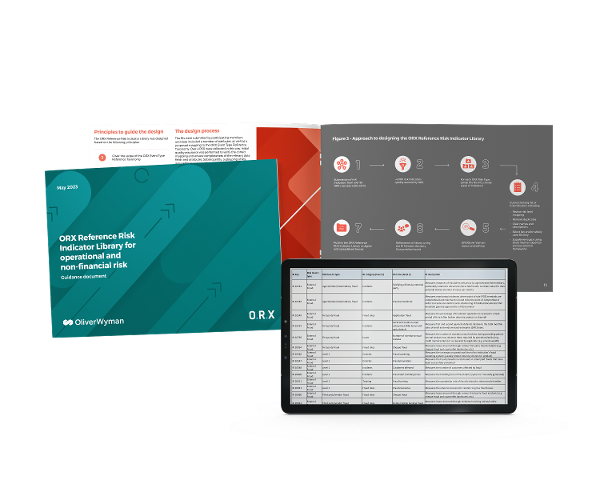Reference Risk Indicator Library
Are you getting value out of your risk indicators?
Book a short call to talk to us about accessing the ORX Reference Risk Indicator Library for operational and non-financial risk management today.
The call will cover:
-
How you can use the ORX Reference Reference Risk Indicator Library to improve your risk management practice
-
A quick demo of the Library Explorer (the interactive online version of the library)
-
What resources you'll get access to if you purchase the library and how you can access as a non-member of ORX.
370
Risk indicators
16
Level 1 risk types
61
Level 2 risk types

Access the financial industry's only comprehensive library of risk indicators
Already used by over 60 financial firms worldwide, the ORX Reference Risk Indicator Library provides an industry-validated framework for effective risk indicators. We developed the library in collaboration with Oliver Wyman and our membership.
Aligned to ORX Reference Operational Risk Taxonomy, the library helps you make sure that you're monitoring your material risks by tracking the most relevant indicators. It provides a structure that helps you to develop your organisation's library and enhances your risk indicator practice.
Book a call to find out more today or download a free introduction for an overview of the library.
Why firms use the library
Drive consistency
The library gives you a framework that drives consistency of definition, triggers and reporting.
Build efficiency
Use the library to ensure your resource is focused on the right areas.
Demonstrate coverage
Use the library to demonstrate that you are actively monitoring your key risks and reacting to any changes.
Show you're aligned to the industry
Use the library to demonstrate to senior managers and regulators that you're aligned to the rest of the industry.
Benchmark and enhance your indicators
Benchmark and standardise your existing risk indicators against industry practice. Use the library to enhance and optimise your risk indicators practice.
Improve the efficiency and effectiveness of your risk indicators
Align to leading industry practice with the ORX Reference Risk Indicator Library
What do you get if you purchase the library?
For a one-time payment of £12,000 you'll get access to the complete ORX Reference Risk Indicator Library, as well as guidance to help you us it and an interactive version of the library.
Stay aligned with the latest practice
As risk indicator practice changes, we'll update the library to reflect the latest developments. If you purchase the library, you'll always have access to the latest updates to ensure you continue to be in line with the industry.
Bundle deal for 2026
Take advantage of our exclusive bundle deals!
Each ORX Reference Library: £12,000 for 2026.
Bundle Pricing Options:
1. Purchase one ORX Reference Library (Control, Risk Indicator or Process and Services):
✓ Add both Taxonomies Guidance for only £1,620 (Save £380).
2. Purchase two ORX Reference Libraries:
✓ Get both Taxonomies Guidance FREE (Save £2,000).
3. Purchase three ORX Reference Libraries:
✓ Get both Taxonomies Guidance FREE, plus a 10% discount on the total Reference Library price.
What is the ORX Reference Risk Indicators library and what are its benefits?
“Risk is an area where we learn most from each other and so having the collective data and insight from 50 financial services firms in one single resource creates an invaluable asset, and one that will continue to grow with rich data over time.”
Tom Ivell, Partner (Financial Services), Oliver Wyman
What do you get if you purchase the library?
The Excel version of the library gives you an editable version of the library. It's especially useful for benchmarking against internal indicators.
In addition to the library itself, we've produced guidance to help you use it and a short report detailing our methodology and industry trends. The guidance covers the library structure and observations on the 16 level 1 risk types covered by the library.
The ORX Reference Risk Indicator Library Explorer is an interactive, online version of the ORX Reference Risk Indicator Library. It helps you explore the library by risk type, see connections between indicators and easily dig into the areas of most interest to you. You can also search for keywords and export different views of the library.
“Our Risk Indicator Practices report last year showed that ONFR functions needed to optimise risk indicator practices in a number of ways. Firstly, by increasing effectiveness through data quality and the identification of predictive indicators and also with timeliness and efficiency in collection through automation. Both ultimately free up 1st and 2nd line capacity and better support active risk management.”
Steve Bishop, Research & Information Director, ORX